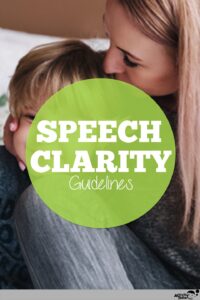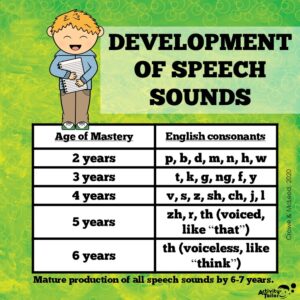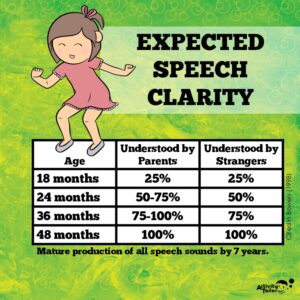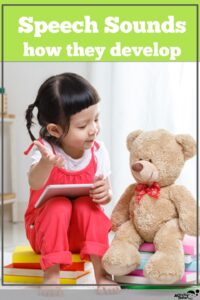Parents are often confused by speech clarity guidelines especially when it comes to late talkers. If you can’t understand what your child is trying to tell you, isn’t that a clarity issue?
Not necessarily.
Late talkers are limited with how much language they have which means they struggle to communicate their wants, needs, and feelings. But there are other children who have language skills within expected ranges that are hard to understand because of they way they form their speech sounds.
How do speech sounds develop?
Many children don’t develop all mature speech sounds in the English language until they’re 6-7 years old. Usually, you will hear bilabials sounds first. These are sounds made with the lips—B, P, M—which are both easier to form and easier to see on a caregiver’s face. Other sounds, especially R and TH, aren’t fully mastered until a child enters school. It’s common to hear some sounds produced correctly in some words or position of words (ex. at the beginning) and incorrectly in others.
Expectations for speech clarity
While speech language pathologists can assess the speech sound inventory of children under 3 years old, more often, it’s all intelligibility. When children start talking they are usually understood 25% of the time. By 4 years old, we expect little ones to be 100% understood by parents and strangers. That’s a big change in a relatively short amount of time!
Remember, being understood doesn’t imply that all the sounds are perfectly pronounced. A child might be easily understood the majority of the time and still have several speech sound errors.
Still concerned? Talk to a speech-language pathologist! We start working with children early, you don’t need to wait until 3 years. Most kids love going to speech and therapy is very effective. In the US, you have the option of going to a private clinician or reaching out to your local early intervention for services.
Looking for help to develop your late talker’s language? Join me for small group coaching!
Special Considerations for Late Talkers
Little ones often master P, B, M, N, D, H and W sounds first (by age 2). By focusing on early words with these sounds, we give late talkers “easier” opportunities. Some examples include: Mom(my), baby, hi, Dad(dy), bye, pop.
This doesn’t mean we should only model words with these sounds! We often understand attempts at words that are far from “perfect” and giving them the chance to hear a wide, varied vocabulary will pay off in the long run. But if you’re looking for some success with a child that is struggling to try words, see if focusing on babbling these early sounds or using words with them helps.
In my experience, late talkers frequently need a little more time to develop speech sounds too. So, if your new talker is a little older and hard to understand, they may simply need a bit more practice. However, if your child has a very limited repertoire of speech sounds and doesn’t have consistent productions of words, contact a speech language pathologist for an evaluation.









